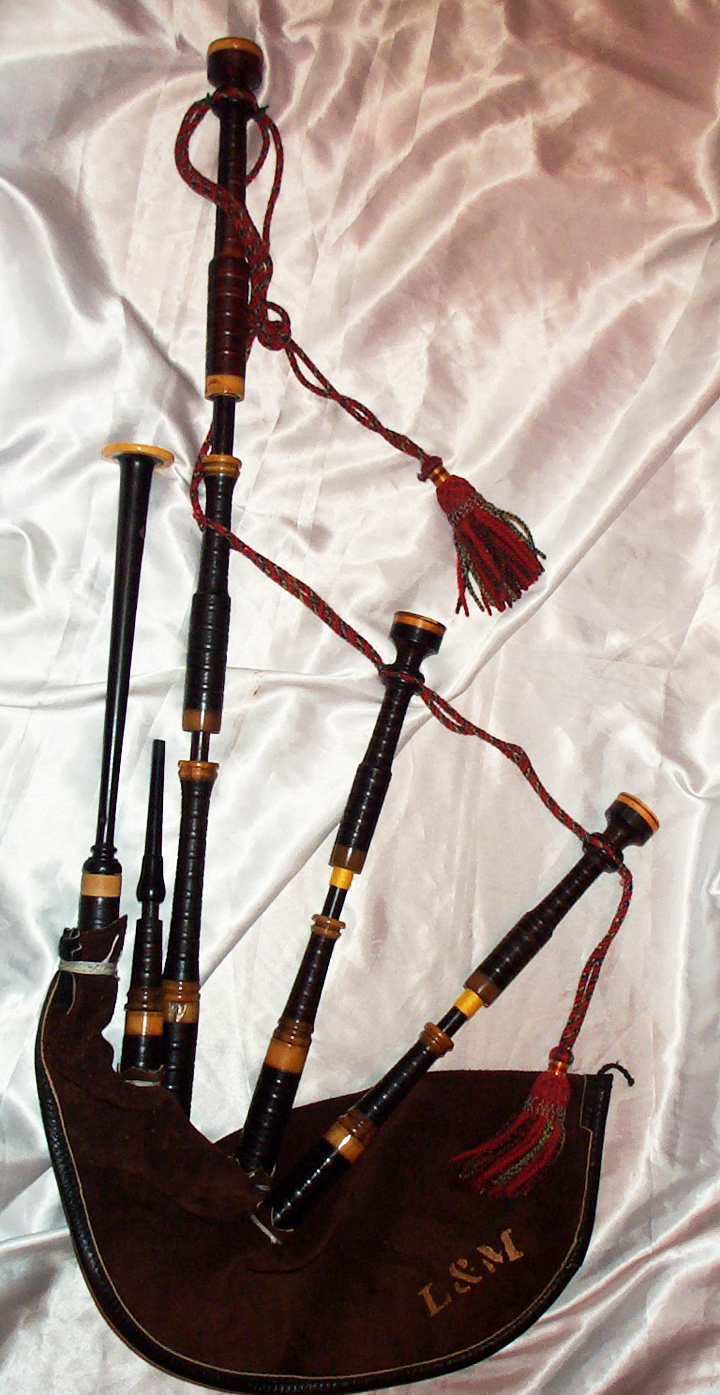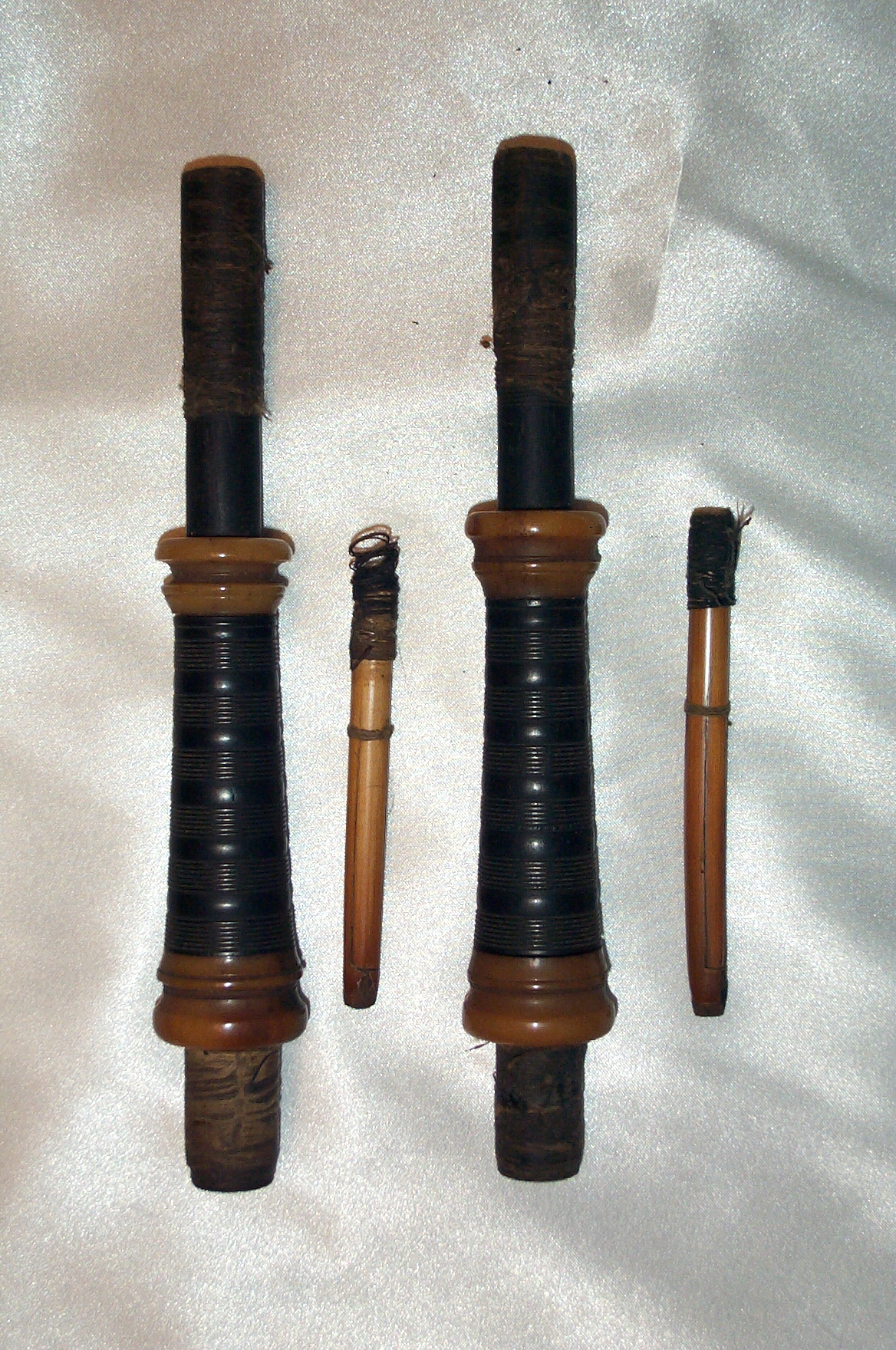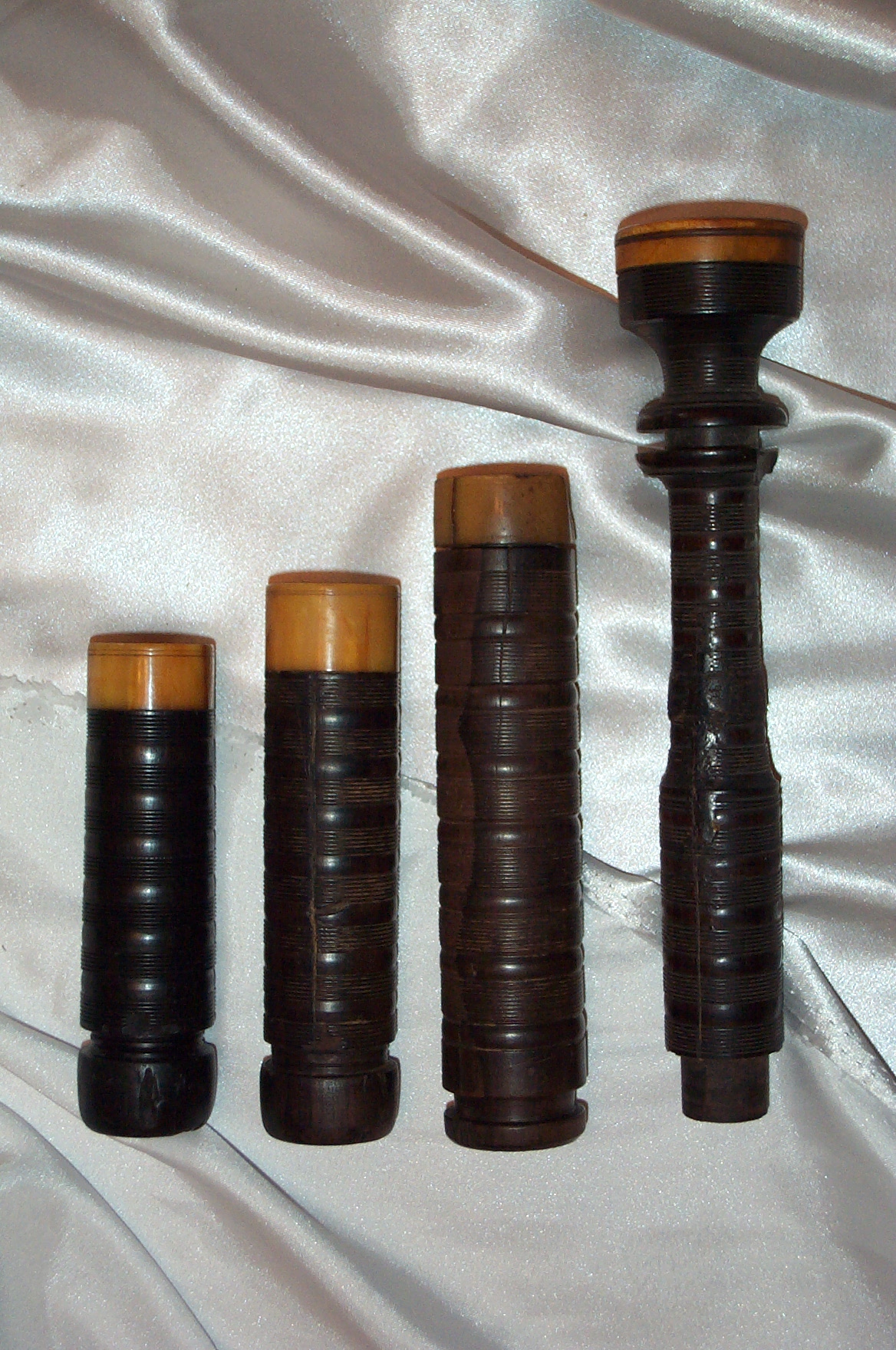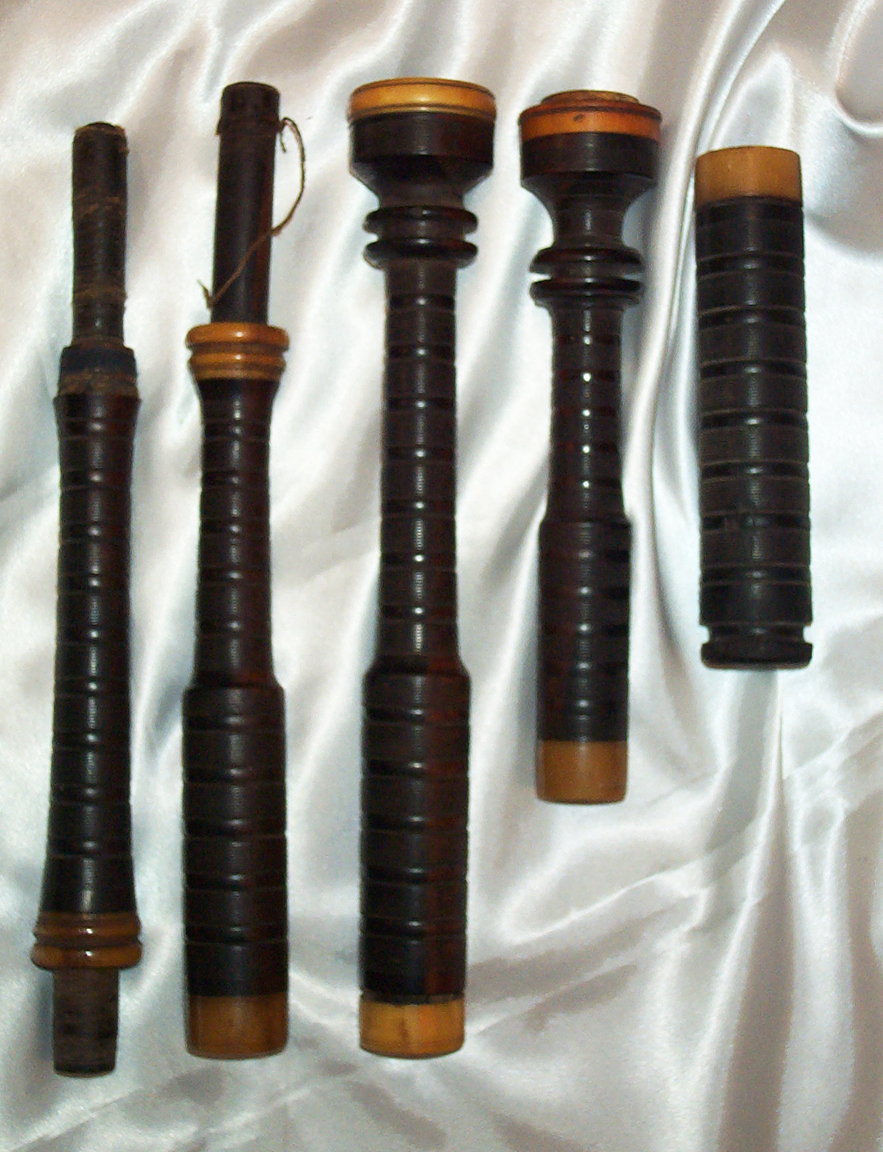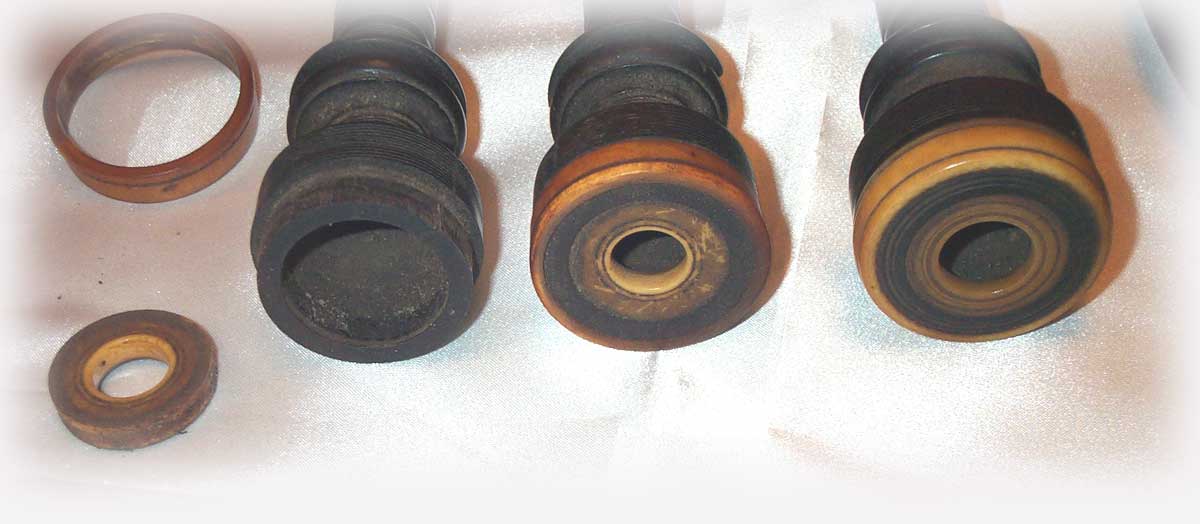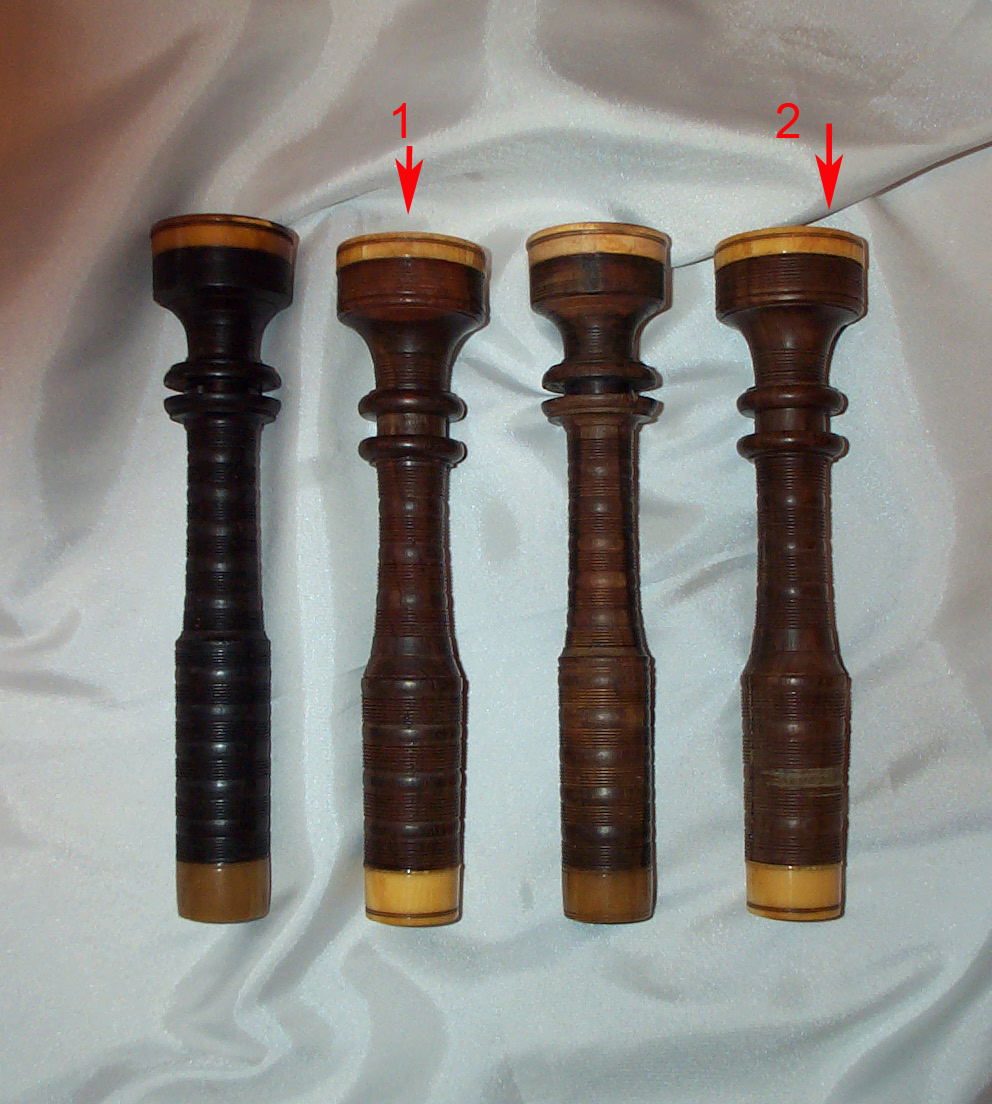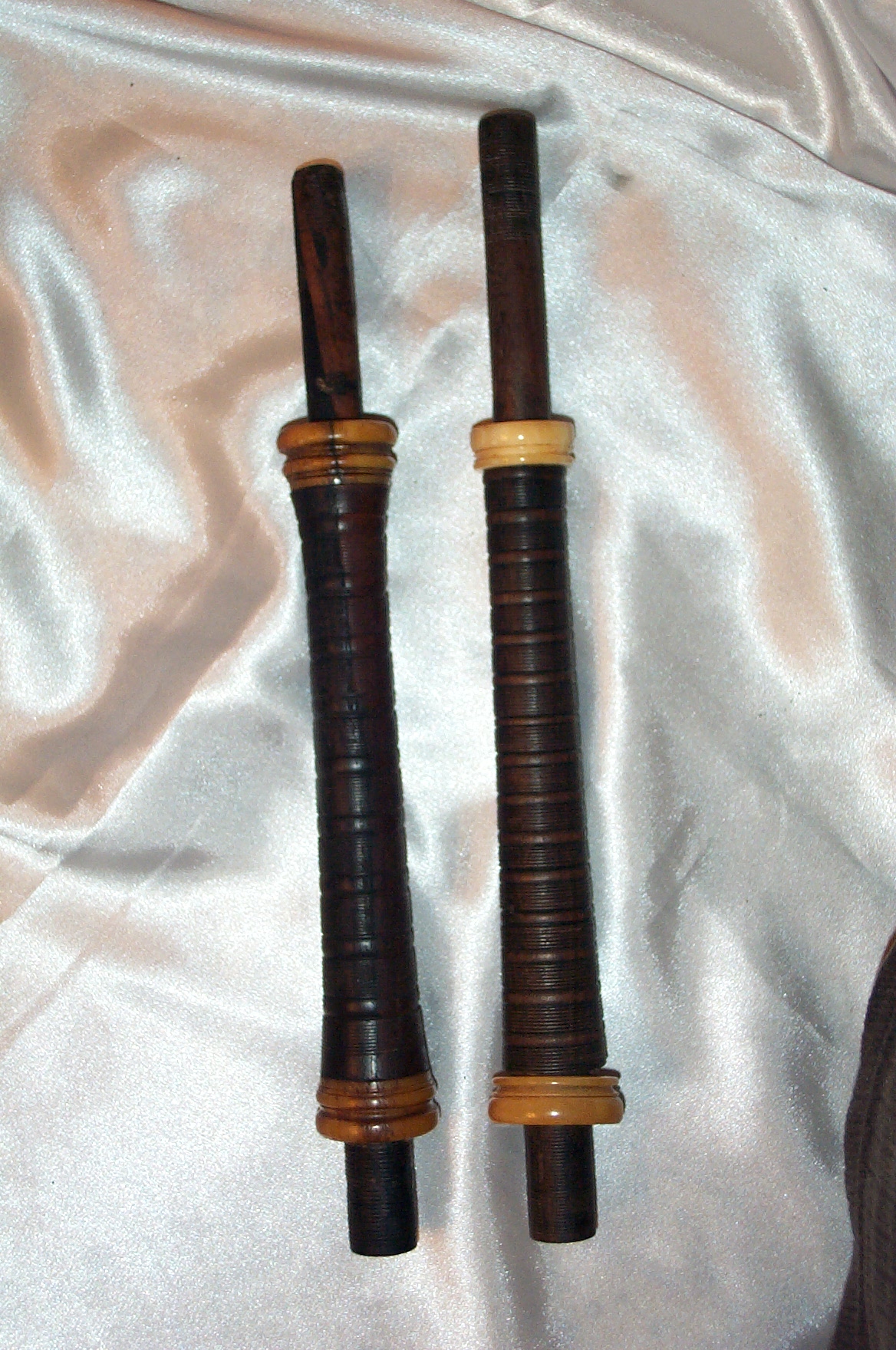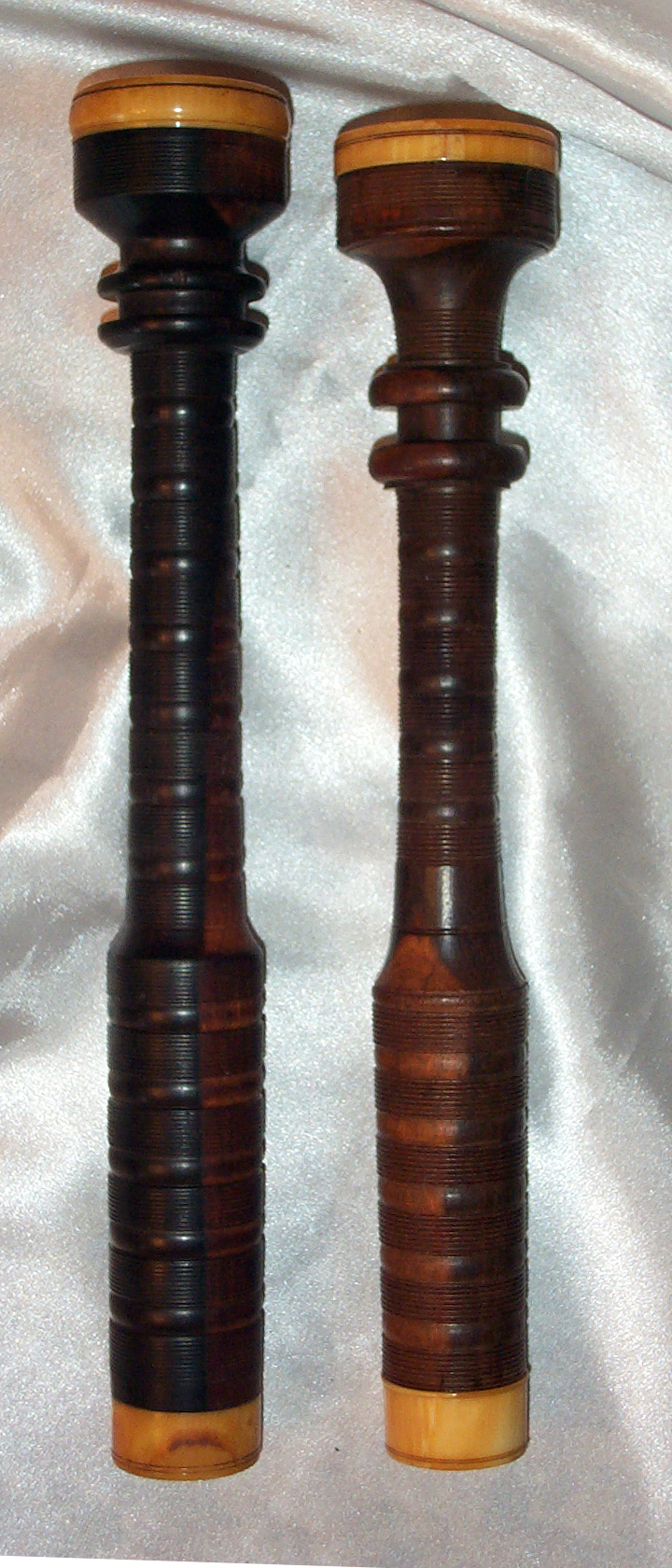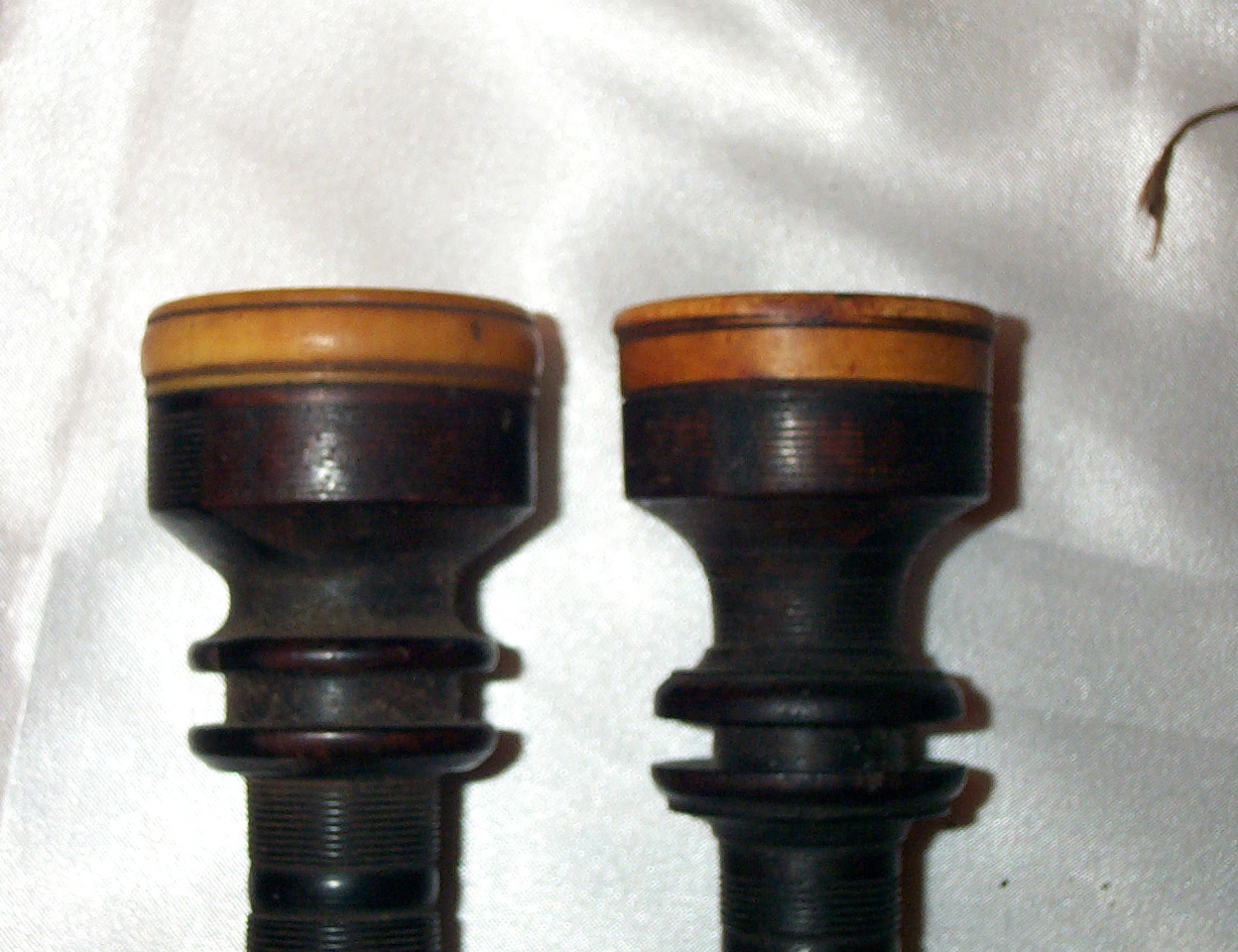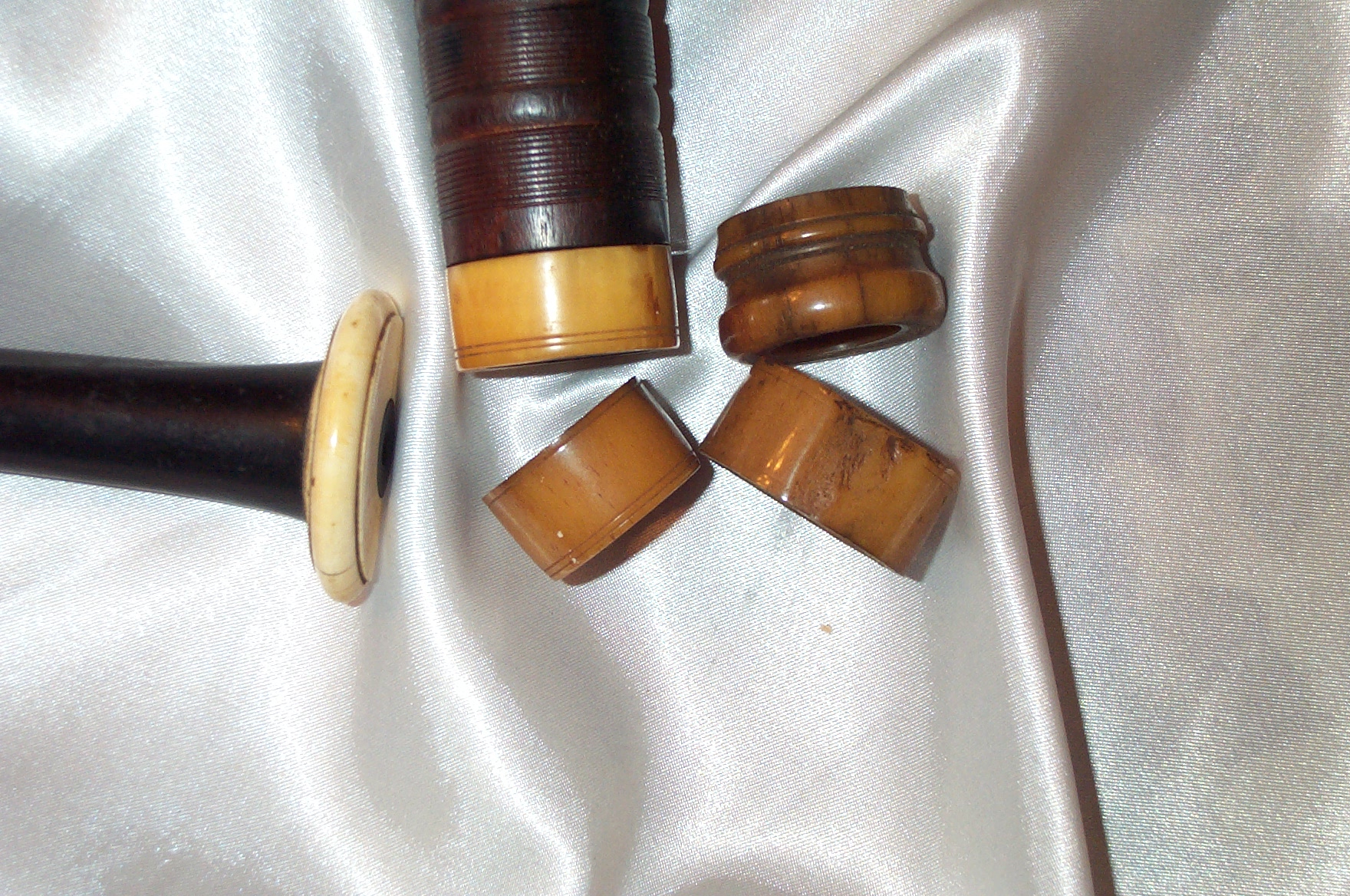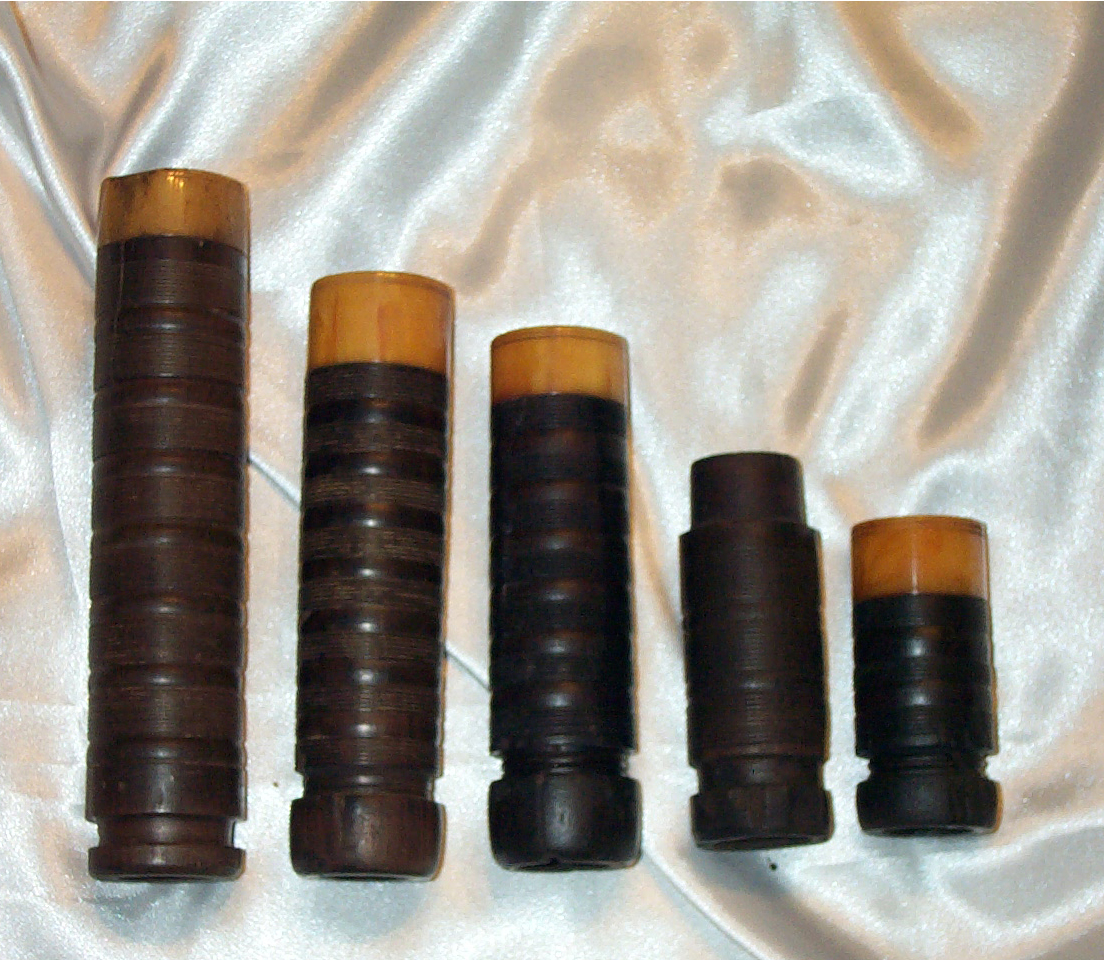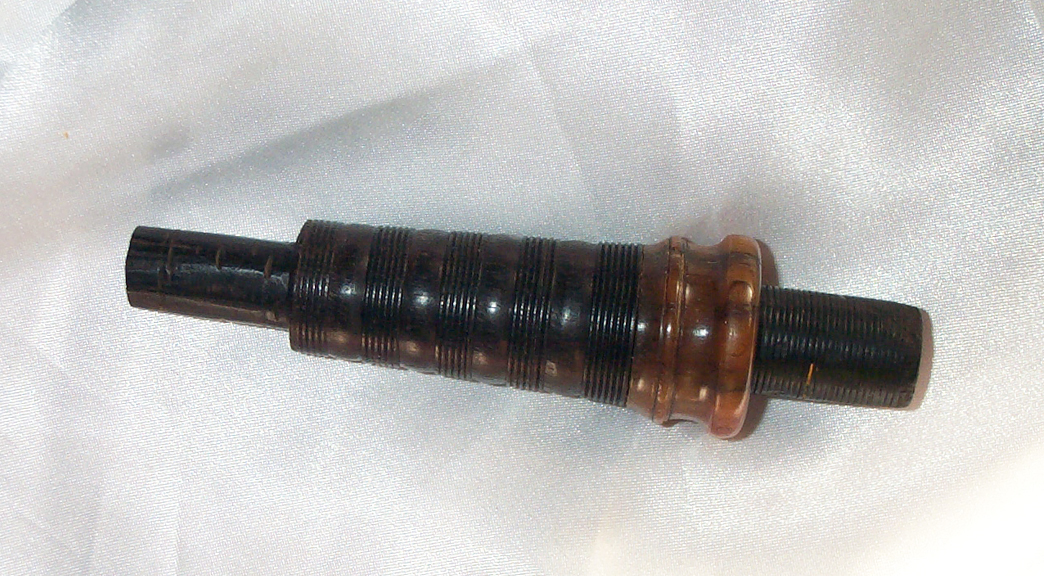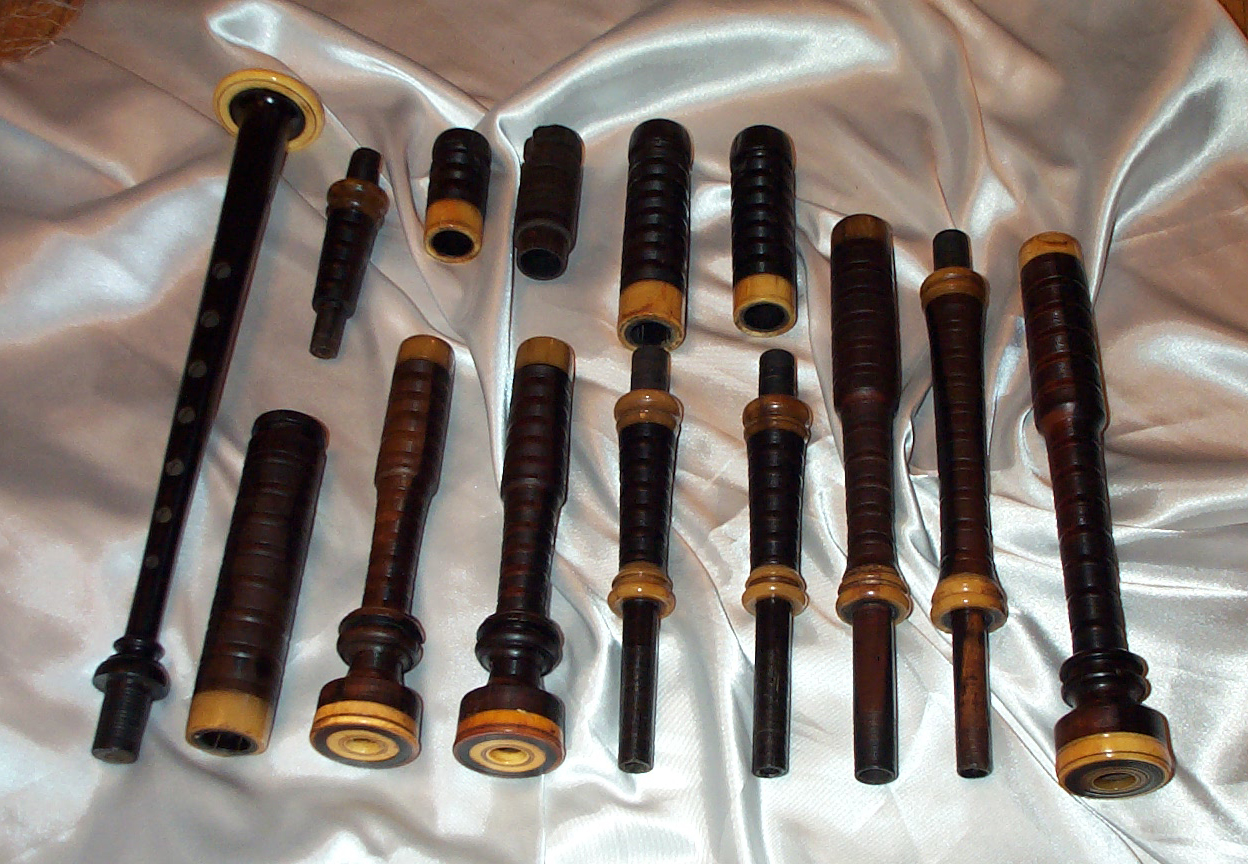This bagpipe is believed to have come to Prince Edward Island, Canada in 1841 with Robert Morrison. Robert, his two brothers, and parents emigrated from the village of Oldshoremore in Eddrachillis Paris, County of Sutherland, Scotland.
Where these older bagpipes are interesting to study and contemplate, it is necessary to treat any attempt to identify the maker with a degree of skepticism. Although there are clues drawn from features seen on bagpipes that are authenticated we know that specific features and design aspects were not exclusive to a particular maker. We also know that makers were not 100% faithful to a given style, design, or internal bore specifications.
My personal speculation on this bagpipe is that it came from an area of Scotland that was under the influence of Hugh Robertson and probably pre-dates Donald MacDonald. Certainly if one does a comparison (see MacDonald bagpipes here) the differences are very obvious. The bass drone is very interesting with the center bead on the ring and the 10 tooth combing. Was this added when the bass drone gained favour among pipers? Why the differences in the two tenor drones?
The pictures are provided here for your consideration. Take from them what you will. Hopefully more information will be brought forward that will one day associate these bagpipes and others in this museum to their makers.
The woods used provide some clues as to age. Those who have seen these bagpipe in person agree that the wood is probably of a fruit tree indigenous to Scotland. This would support the notion that the bagpipe was made in the late 1700's or very early 1800's. Perhaps.
Beading, combing, and the general design of the two tenors suggest that they were made by the same maker at the same time. Fixtures are bone with ivory bushings.
The tenor to the left is 8.4375 inches tall. The tuning bore is .675 X 3 inches deep. The thru-bore is .515 and the bushing bore is .554 inches. The bell is 1.175 inches wide at the bushing and 1.25 inches deep.
The tenor to the right 8.3125 inches tall. The tuning bore is .675 X 3 inches deep. The thru-bore is .515 and the bushing bore is .534 inches. Bell dimensions are as above.
Beading is hand-cut, inconsistent and about .226 inches. Combing is 6 teeth at 26 TPI.
Where these older bagpipes are interesting to study and contemplate, it is necessary to treat any attempt to identify the maker with a degree of skepticism. Although there are clues drawn from features seen on bagpipes that are authenticated we know that specific features and design aspects were not exclusive to a particular maker. We also know that makers were not 100% faithful to a given style, design, or internal bore specifications.
My personal speculation on this bagpipe is that it came from an area of Scotland that was under the influence of Hugh Robertson and probably pre-dates Donald MacDonald. Certainly if one does a comparison (see MacDonald bagpipes here) the differences are very obvious. The bass drone is very interesting with the center bead on the ring and the 10 tooth combing. Was this added when the bass drone gained favour among pipers? Why the differences in the two tenor drones?
The pictures are provided here for your consideration. Take from them what you will. Hopefully more information will be brought forward that will one day associate these bagpipes and others in this museum to their makers.
The woods used provide some clues as to age. Those who have seen these bagpipe in person agree that the wood is probably of a fruit tree indigenous to Scotland. This would support the notion that the bagpipe was made in the late 1700's or very early 1800's. Perhaps.
Beading, combing, and the general design of the two tenors suggest that they were made by the same maker at the same time. Fixtures are bone with ivory bushings.
The tenor to the left is 8.4375 inches tall. The tuning bore is .675 X 3 inches deep. The thru-bore is .515 and the bushing bore is .554 inches. The bell is 1.175 inches wide at the bushing and 1.25 inches deep.
The tenor to the right 8.3125 inches tall. The tuning bore is .675 X 3 inches deep. The thru-bore is .515 and the bushing bore is .534 inches. Bell dimensions are as above.
Beading is hand-cut, inconsistent and about .226 inches. Combing is 6 teeth at 26 TPI.
The shots above show the tenor tops and one bell. There's nothing tremendously revealing about this other than none of the fittings were threaded into place. The bushing is tapered to provide a better seal.
A comparison with these other old tenor tops is interesting. The shorter tenors (1 & 2) with the rounded cord beads are also believed to be from the east coast of Canada but without a documented history. The tuning chambers are .622 inches by 3.25 inches deep. The thru-bore is .440 inches and the bushing bore is .545 inches. The bell is 1.000 inches wide by 1.383 inches deep. Beading is .227 and combing is 8 teeth and is 24 TPI. The overall length of the section is 8.1874 inches.
The bass drone, from stock to top, does not match the tenor pieces at all. The bass bottom is 11.500 inches long with a .400 thru-bore. There is damage to the top of the pin, which may have been longer at one time. The mid section is 11.750 inches long. The tuning chamber is .690 X 3 inches deep and the small bore is huge at .500 inches. The bass top is 11.5 inches long (292 mm). The tuning chamber is .730 X 3 inches deep. The small bore is .600 and the bushing bore is .670 inches. The bell is 1.175 X 1.175 inches. Beading is .25 inches and combing is 10 teeth at 28 TPI.
Of particular interest is the proportion of one section to the other. As you can see, the bass mid-section is the longest and the bass bottom being the shortest. In Hugh Cheape's MacDonald bagpipe (some measurements are listed below) the bass bottom was shortest, with the longest being the bass top-section at 317 mm.
Mr. Cheape also indicates that the Donald MacDonald bass bell is 56 mm in diameter (compared to 46 mm for the Morrison bagpipe) with a bushing bore of "almost 20 mm" compared to the Morrison bagpipe bushing of 17 mm.
Of particular interest is the proportion of one section to the other. As you can see, the bass mid-section is the longest and the bass bottom being the shortest. In Hugh Cheape's MacDonald bagpipe (some measurements are listed below) the bass bottom was shortest, with the longest being the bass top-section at 317 mm.
Mr. Cheape also indicates that the Donald MacDonald bass bell is 56 mm in diameter (compared to 46 mm for the Morrison bagpipe) with a bushing bore of "almost 20 mm" compared to the Morrison bagpipe bushing of 17 mm.
By comparison, the bass bottom to the right, which I believe to be older, is a full 12 inches (304 mm) from end to end. You can see the obvious differences. Beading on the comparison bass bottom is .166 inches and combing is 7 teeth at 28 TPI. The bore is .345 inches.
Again, Hugh Cheape writes of his Donald MacDonald bagpipe; "A critical detail should be highlighted in the much shorter bottom-joint of the drone at 277 mm." Mr. Cheap writes further that "the reed-seat is relatively large at just over 11 mm." The reed-seats on both of the bottom sections pictured herein also measure just over 11 mm.
Again, Hugh Cheape writes of his Donald MacDonald bagpipe; "A critical detail should be highlighted in the much shorter bottom-joint of the drone at 277 mm." Mr. Cheap writes further that "the reed-seat is relatively large at just over 11 mm." The reed-seats on both of the bottom sections pictured herein also measure just over 11 mm.
The comparison bass top, which matches the comparison tenors, is 11.125 inches long. The tuning chamber is .670 X 3.5 inches deep. The thru-bore is .525 and the bushing bore is .635 inches. The bell is 1.000 X 1.130 inches deep.
Again, as a matter of comparison, Hugh Cheape indicated in The Piping Times (Vol. 57 No. 2) regarding a Donald MacDonald bagpipe in his care and custody; "...the length of the Donald MacDonald top-joint is 317 mm..."
Again, as a matter of comparison, Hugh Cheape indicated in The Piping Times (Vol. 57 No. 2) regarding a Donald MacDonald bagpipe in his care and custody; "...the length of the Donald MacDonald top-joint is 317 mm..."
Again the stocks match the drones. The bass is 6.250 inches long and the bore is .770 at the bottom, which is probably a truer measurement. The longer tenor stock is 5.3125 inches long while the other is 4.6875 inches long. The bore on the longer stock is .740 while the bore on the shorter stock is .780 inches. The chanter stock is 3.375 inches long X .780 and the bottom has been crudely enlarged. The blowpipe stock is 2.700 inches long X .770 inches. The combs on the bass are 10 teeth, the tenors are 6 teeth, 9 teeth on the chanter stock and 6 on the blowpipe stock. I believe that the tenor and blowpipe stocks are original to the set.
Unknown # 3
